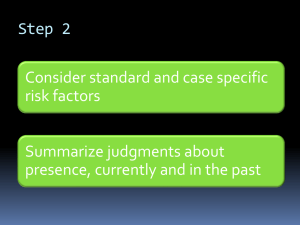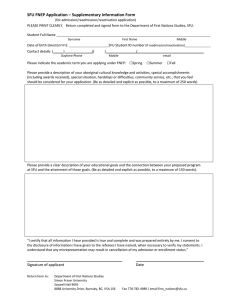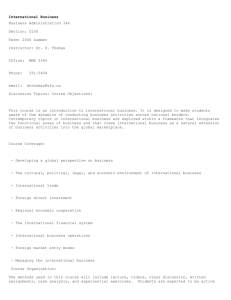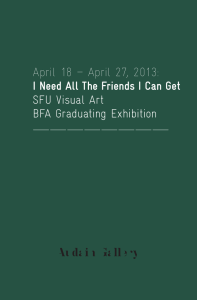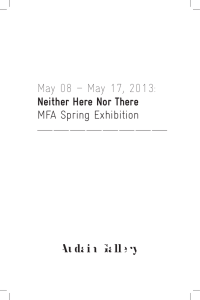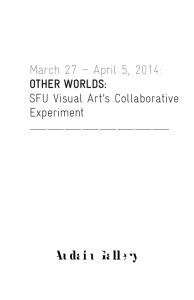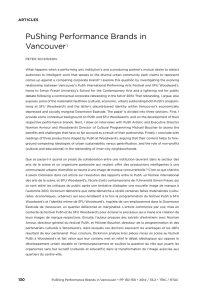3 Rethinking arts & culture Inspiration for change:
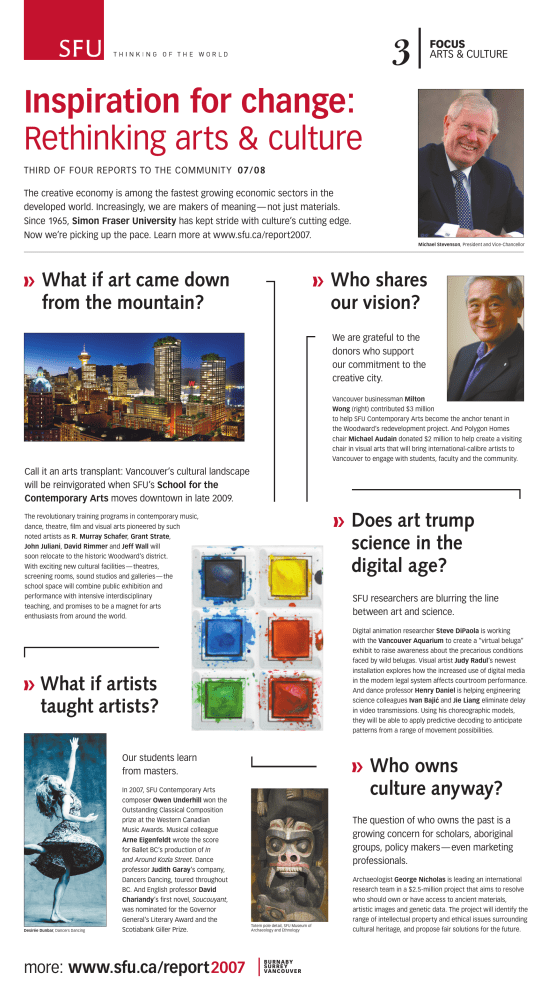
3
FOCUS
ARTS & CULTURE
Inspiration for change:
Rethinking arts & culture
ThiRd OF FOUR REpORTS TO ThE COmmUniTy 07/ 08
The creative economy is among the fastest growing economic sectors in the developed world. increasingly, we are makers of meaning — not just materials.
Since 1965, Simon Fraser University has kept stride with culture’s cutting edge. now we’re picking up the pace. Learn more at www.sfu.ca/report2007.
What if art came down
from the mountain?
Michael Stevenson, president and Vice-Chancellor
Who shares
our vision?
We are grateful to the donors who support our commitment to the creative city.
Vancouver businessman Milton
Wong (right) contributed $3 million to help SFU Contemporary Arts become the anchor tenant in the Woodward’s redevelopment project. And polygon homes chair Michael Audain donated $2 million to help create a visiting chair in visual arts that will bring international-calibre artists to
Vancouver to engage with students, faculty and the community.
Call it an arts transplant: Vancouver’s cultural landscape will be reinvigorated when SFU’s School for the
Contemporary Arts moves downtown in late 2009.
The revolutionary training programs in contemporary music, dance, theatre, film and visual arts pioneered by such noted artists as R. Murray Schafer, Grant Strate,
John Juliani, David Rimmer and Jeff Wall will soon relocate to the historic Woodward’s district.
With exciting new cultural facilities — theatres, screening rooms, sound studios and galleries — the school space will combine public exhibition and performance with intensive interdisciplinary teaching, and promises to be a magnet for arts enthusiasts from around the world.
What if artists
taught artists?
Desirée Dunbar, dancers dancing
Our students learn from masters. in 2007, SFU Contemporary Arts composer Owen Underhill won the
Outstanding Classical Composition prize at the Western Canadian music Awards. musical colleague
Arne Eigenfeldt wrote the score for Ballet BC’s production of In
and Around Kozla Street. dance professor Judith Garay’s company, dancers dancing, toured throughout
BC. And English professor David
Chariandy’s first novel, Soucouyant, was nominated for the Governor
General’s Literary Award and the
Scotiabank Giller prize.
Totem pole detail, SFU museum of
Archaeology and Ethnology
Does art trump
science in the
digital age?
SFU researchers are blurring the line between art and science. digital animation researcher Steve DiPaola is working with the Vancouver Aquarium to create a “virtual beluga” exhibit to raise awareness about the precarious conditions faced by wild belugas. Visual artist Judy Radul’s newest installation explores how the increased use of digital media in the modern legal system affects courtroom performance.
And dance professor Henry Daniel is helping engineering science colleagues Ivan Baji and Jie Liang eliminate delay in video transmissions. Using his choreographic models, they will be able to apply predictive decoding to anticipate patterns from a range of movement possibilities.
Who owns
culture anyway?
The question of who owns the past is a growing concern for scholars, aboriginal groups, policy makers — even marketing professionals.
Archaeologist George Nicholas is leading an international research team in a $2.5-million project that aims to resolve who should own or have access to ancient materials, artistic images and genetic data. The project will identify the range of intellectual property and ethical issues surrounding cultural heritage, and propose fair solutions for the future.
more: www.sfu.ca/report
2007
SUrrey vanCOUver

